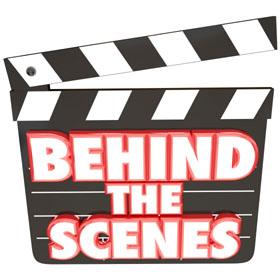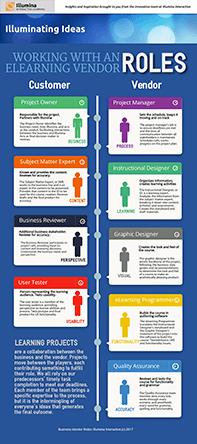Building eLearning: Behind the Scenes with Instructional Design
Last fall we began our backstage tour of Illumina’s process for creating eLearning. We’ve looked at Project Management, Graphic Design, Quality Assurance, and Development to learn what it takes to create a world-class look and feel for eLearning.
Our series wouldn’t be complete if we didn’t catch up with our experts who align content, activities and assessments with learning goals. We close out our behind the scenes series with Instructional Design. Our blog editor caught up with Mary Ellen Whitaker and Jean Marrapodi, Illumina’s instructional designers, to hear how they contribute to the process.
Instructional Design: The Nuts and Bolts
Rachel: Hi ladies. Thanks for taking the time out of your busy schedule to chat with me today.
Mary Ellen: I’m happy to share.
Jean: It’s my pleasure. Thanks for asking.
Rachel: Have you always done eLearning?
Mary Ellen: Yes. My main focus as an instructional designer has always been designing eLearning. In the early 90s, I worked in educational publishing, creating technology components for elementary textbook series. We weren’t calling it eLearning back then, but I developed a love for bringing computer-delivered content to life for students. In the mid-90s, I became the first instructional designer for a company that was an early innovator in eLearning for adult learners.
Jean: I was one of the early adopters of eLearning, and wound up pioneering it in several of the companies I worked for as it gained popularity. In my younger years, I taught elementary and special ed classes, but when I moved to New England, the teacher’s market was glutted so I side-stepped into corporate training. In the beginning, I did both design and delivery, but began to focus more on design as my career progressed.
Rachel: Do you have to go to school to become an instructional designer?
Mary Ellen: You don’t have to have a formal degree in instructional design. I have colleagues who got into the field having worked in education, publishing (like me), or even human resources. However, no matter what your background, you do need to understand certain principles and best practices. You can learn a lot from fellow instructional designers, from taking webinars and workshops, and from some of the good mentoring programs that exist out there. There are also a lot more degree programs in the field now than there were when I got started.
Jean: No, you don’t have to, but I found it really helped. Once I began to do more design, I wanted to learn more, so I completed a masters in Online Instructional Design, and loved it so much, I continued on to my PhD in Adult Education.
Rachel: You did that online too, right?
Jean: Right. I completed both at Capella University, a totally online college. The same year I got my PhD, I completed my CPLP, ATD’s certification for learning and performance. I guess you could call me a learning junkie.
Rachel: What is your process when you approach a project?
Mary Ellen: It depends on the project. At Illumina we do custom eLearning design and development, so every project is different. Sometimes our client has an in-house training staff that has done a needs analysis already. Sometimes they’ve gone so far as to create the shell of their course but don’t know how to turn it into good eLearning. We start our process at various stages in the development cycle, depending on what our client presents us with at the beginning. No matter what that is, we never assume that the client is right about what they want or need. We have to determine for ourselves the best solution that will meet the needs of their learners.
Jean: For me, I like to do a pretty comprehensive needs analysis. I want to understand the problem that’s driving the need, as well as the context and the learners who will be taking the course. Then I define a goal statement of what they need to know and do as a result of taking the class. From there, I establish the outcomes and objectives, and how we’re going to assess that the learners have met the goal. It isn’t until that point that I begin to add content and activities.
Rachel: What is your final end product?
Jean: We have a couple of deliverables. We draft a design document, which contains the results of the needs analysis, parameters of the project, and a high-level outline of the program. That is the framework for scripts or storyboards. I also like to create a curriculum architecture that defines the flow of the course, and a learning map that outlines the learner experience.
Mary Ellen: As a Learning Architect, Jean usually gets more involved with creating curriculum architecture than I do. We do both create design documents and outlines and have to set parameters for the project. I’d say most of my time on a project is spent during the storyboarding phase. This means I have to take the actual content we need to teach and lay it out using text, audio narration, graphics, and animation. It’s my job to determine what will happen on each screen of a course. Our client reviews the storyboard, and, once it’s approved, it becomes the blueprint our developers use during programming.
Rachel: What is the biggest headache you face in your design?
Mary Ellen: That’s a big question! The greatest challenge is creating the most engaging, accurate, and sound training experience while keeping within certain budgetary parameters and time constraints. Many factors are always at play: being thorough without making the course too long; creating an engaging experience for the learner without blowing the budget; helping the client understand that what they envision may have to be modified in any number of ways.
Jean: When I work with content experts, they often have a hard time prioritizing what is essential and what can be eliminated. They also want to tell learners everything. My goal is to keep the main thing the main thing and to build an experience that enables the learner to take away the skills to do the job. I try to scaffold the learning and create things that replicate what they will do on the job. Sometimes that includes the learner making mistakes, taking risks, or guessing. Those are deliberately built in to foster better learning, and equip them with the strategies they will need to figure things out once they are on their own.
Rachel: What’s your favorite part of ID?
Mary Ellen: I love communicating information through all of the elements we have available to us as eLearning designers. Once I know what learners need from a training experience, it’s a lot of fun to figure out how to deliver state-of-the-art eLearning content that will draw them in, that will keep them engaged, and that they will remember later. As I’m creating a storyboard, I like to picture my typical learners and write as if I’m talking to them, whether they’re employees in a corporate environment, healthcare professionals, or folks who work in any other industry.
Jean: (laughs) Seeing that the learners get it. It’s funny, that’s the same thing I love when I’m teaching in a workshop or synchronous webinar, or years ago when I was working with little kids. That lightbulb moment of discovery when it all comes together brings me such delight. It’s a little harder with eLearning because we have to wait for evaluation and assessment results once a program is implemented, but I find it very rewarding when things work the way they were designed.
Rachel: What advice can you share for clients and practitioners to avoid some of the common errors you contend with?
Mary Ellen: One piece of advice I’d love to convey to clients is: Be serious about reviews. Before you tell us, your eLearning development partner, that you’ve approved content or graphic design or interactivity types, pause and ask yourself a few questions. Do you need to go over things one more time to be absolutely sure the material meets your needs and expectations? Is there anyone else–either within or outside of your organization–who needs to weigh in? Additional changes too late in the process can throw off both the schedule and budget. To practitioners, I’d say to remember that the eLearning industry is constantly evolving! Instructional Designers don’t just design learning–we also need learning ourselves.
Jean: We are both experts in our fields. You are the expert in the program content. I’m an expert in learning. Trust me. Our goal is to collaborate on the project, but I bring an outsider’s insights and a learning experience designer’s thinking to the table. You don’t tell an architect building your home how to draw up a plan. You bring them in for their expertise. Allow your learning team to do what we do best. You’ll get much better results in the end.
Rachel: Thanks for your insights, Jean and Mary Ellen. We’ve passed the baton from instructional design all the way to final development and sign off, and it has become clear that the team at Illumina are experts in eLearning as well as collaboration. We hope our readers have enjoyed meeting the people behind the projects.
Are your eLearning results less than what you’d like them to be? Drop us a line, or give us a call, and let’s chat about it. Let our award-winning team help you create Good eLearning. Done well.





